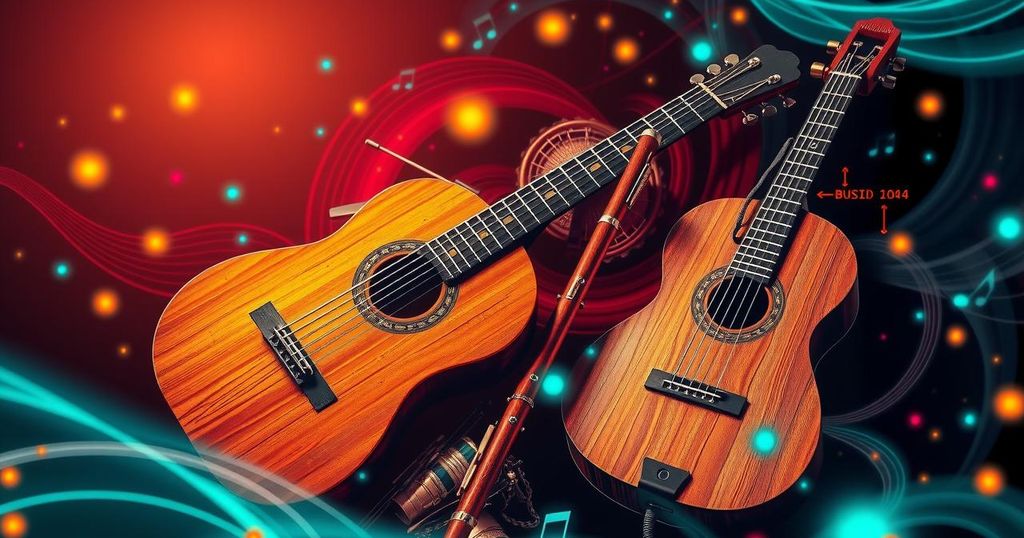Revitalizing Tradition: The Role of AI in National Ballad Composition
Artificial intelligence is transforming music composition, particularly in creating national ballads. A new model combines Markov Chains and Bidirectional Recurrent Neural Networks, generating melodies that reflect ethnic characteristics. The AI-driven approach enhances creativity, addresses educational needs, and preserves cultural heritage while showing promise for future innovations in emotional expressiveness and adaptability.
Artificial intelligence (AI) is revolutionizing music composition, ushering in unprecedented innovations. A recent study reveals how AI algorithms can create national ballads that reflect distinct cultural traits, blending tradition with technology. The sophisticated model merges Markov Chains (MC) and Bidirectional Recurrent Neural Networks (Bi-RNN) to generate melodies rich in emotional depth, reminiscent of authentic national ballads.
National ballads are more than mere songs; they embody deep emotional and historical significance in Chinese culture, capturing the essence of folk expressions. However, crafting these intricate melodies can be complex. Fortunately, modern technology offers solutions to streamline this creative process, making it more accessible.
The proposed AI model uses MC to design baseline melodies through statistical analysis, predicting note transitions effectively. Once the basic structure is established, the Bi-RNN enhances rhythm and emotional nuances using deep learning, reverberating with the authentic spirit of ethnic music.
Through experimentation, this model was shown to outperform both traditional manual methods and the MC alone, showcasing significant improvements in creativity and fidelity to ethnic styles. The emergence of such technology presents new horizons for music education, enabling preservation and innovative expansion of cultural heritage. AI’s role in creativity is now critical for both educators and students.
Wu et al. (2019) highlighted the urgent need for adaptive learning strategies, stressing the integration of diverse methods to aid music composition. Similarly, Wu and Chen (2021) emphasized experiential learning through innovative curricula connected to national music composition, reinforcing the study’s educational implications.
With deep learning’s analytical prowess, this research addresses previous geographical and resource limitations in creating national ballads. The methodology seeks to revive the genre, utilizing AI to analyze and replicate the intrinsic melodic structures, promoting the evolution of traditional soundscapes.
The model achieves not just artistic guidance but enhances educational equity by making musical resources easily accessible. Previous advancements, as noted by Min et al. (2022), demonstrate how AI-generated compositions can closely mirror human creativity. Further studies by Bihani et al. (2023) affirm the value of fusing AI with artistic practice to produce coherent and aesthetically pleasing music.
Central to this research is the traditional pentatonic scale of Chinese national ballads, which, in the absence of half-step intervals, fosters fluid melodies and harmonious themes. The algorithm efficiently synthesizes these elements, reflecting the rich cultural tapestry of national ballads.
The experimental design evaluated a selection of thirty national ballads—ten each from manual compositions, AI-generated pieces via the Markov Bi-RNN model, and MC compositions—using criteria such as melody, rhythm, aesthetic quality, and emotional content.
The evaluation revealed that the Markov Bi-RNN model achieved respectable scores: 85.1 for melody, 88.3 for rhythm, and 87.1 for emotional expression. While these scores were lower than the manually created works, which scored 95.7, 93.2, and 89.7, it signals a promising foundation for potential improvement.
Further assessments with the Lakh MIDI Dataset reinforced the model’s adaptable performance across styles, underscoring its applicability in music composition as a whole. Yet, the study also recognizes the limitations of AI, particularly regarding emotional expressiveness—nuances that remain challenging for algorithms.
For future endeavors, researchers are encouraged to innovate and deepen AI’s capabilities, striving for compositions with richer emotional and cultural representations. Exploring AI’s role in traditional arts emphasizes technology’s intersection with cultural heritage, ensuring the continuity of folkloric traditions amidst globalization’s influences.
This research underscores the transformative potential of AI in redefining traditional music composition. The synergy between AI and ethnic creativity paves the way for a future where technology and cultural heritage flourish together, creating a harmonious blend of the old and the new.
In conclusion, the study illuminates the promising intersection of artificial intelligence and traditional music composition. By blending innovative technology with the rich heritage of national ballads, AI paves the way for the preservation and evolution of cultural expressions. As researchers push the boundaries of AI capabilities, the future looks bright, fostering creativity and accessibility in music education while honoring ethnic roots amidst the pressures of modernization.
Original Source: evrimagaci.org




Post Comment